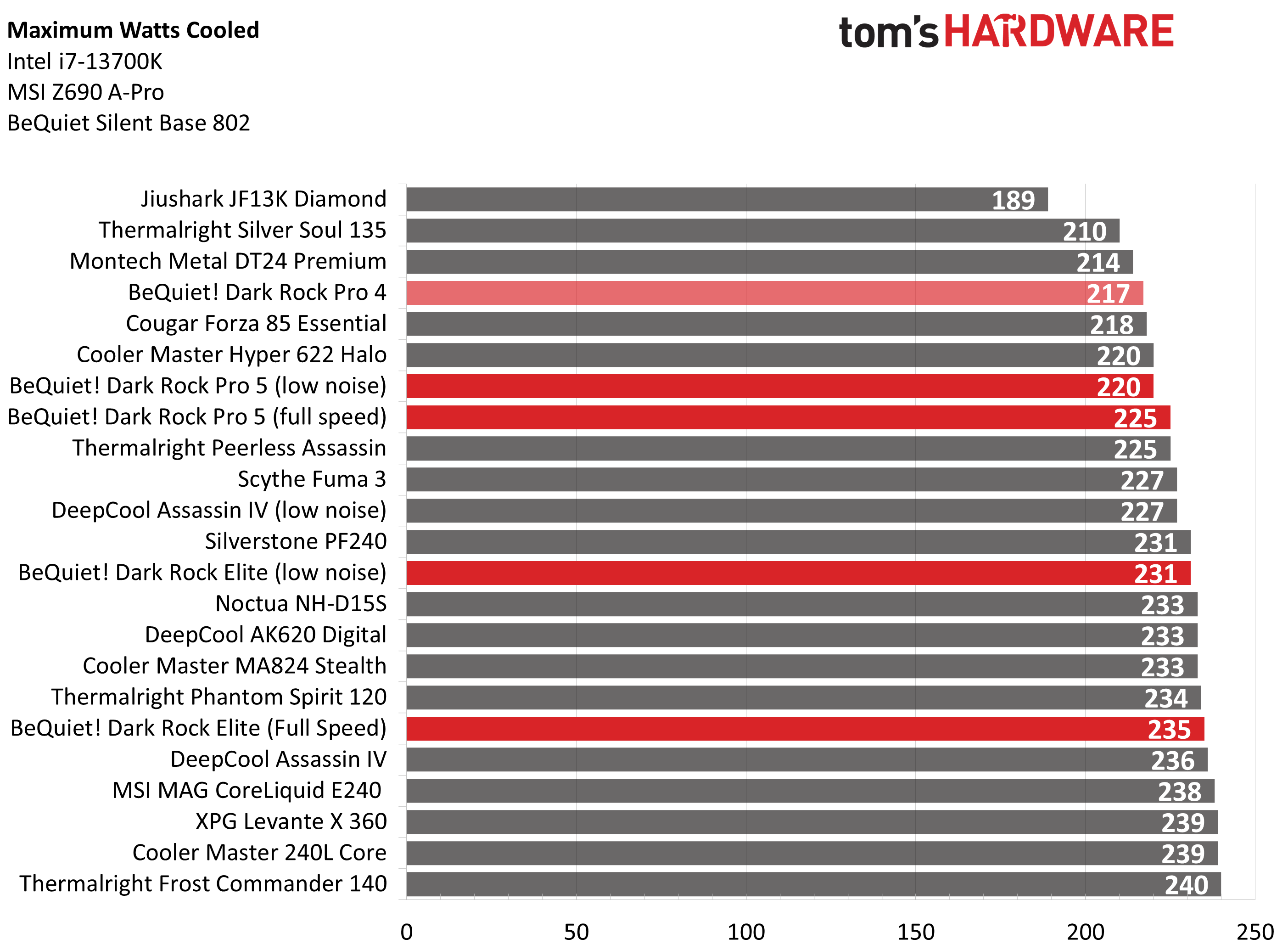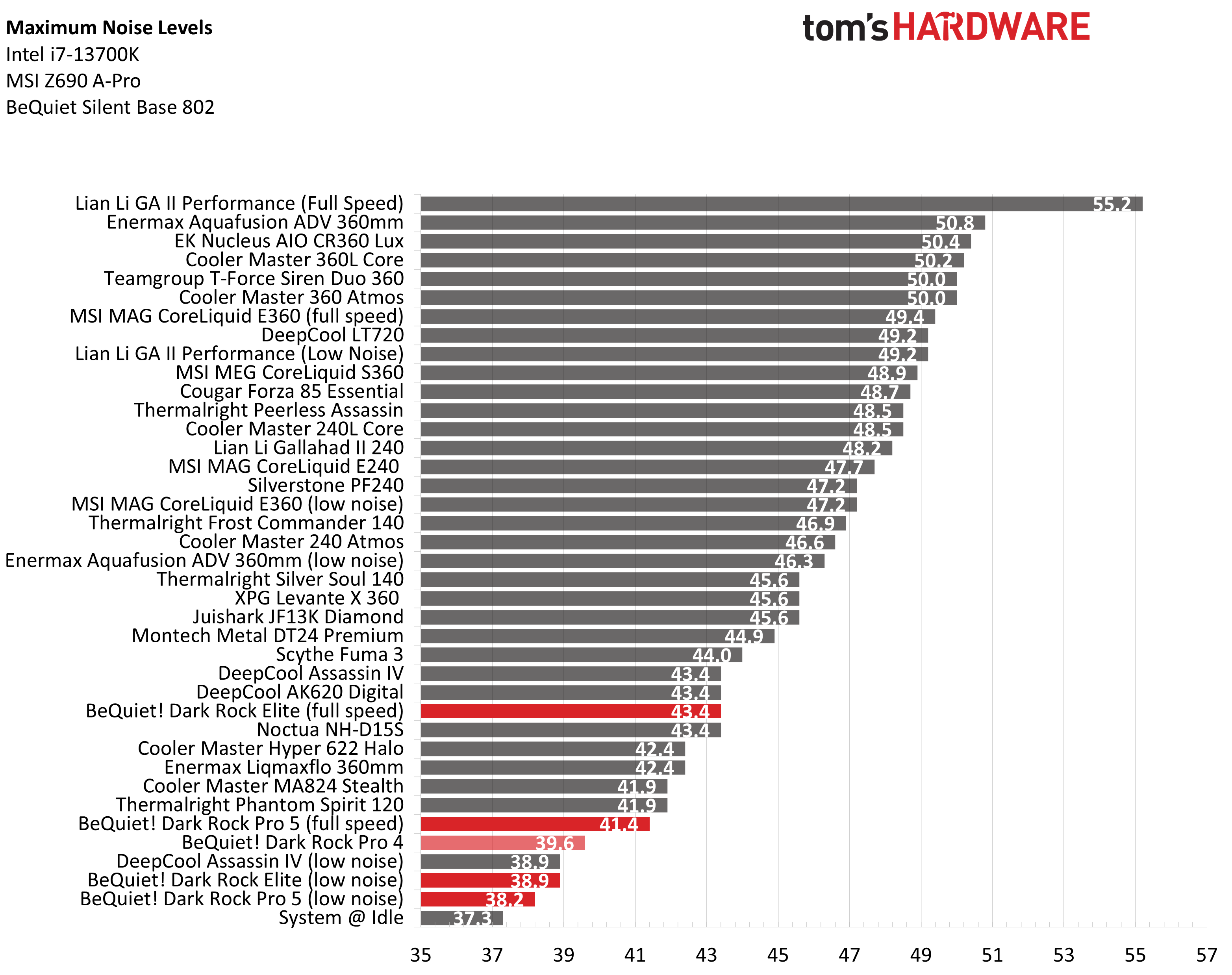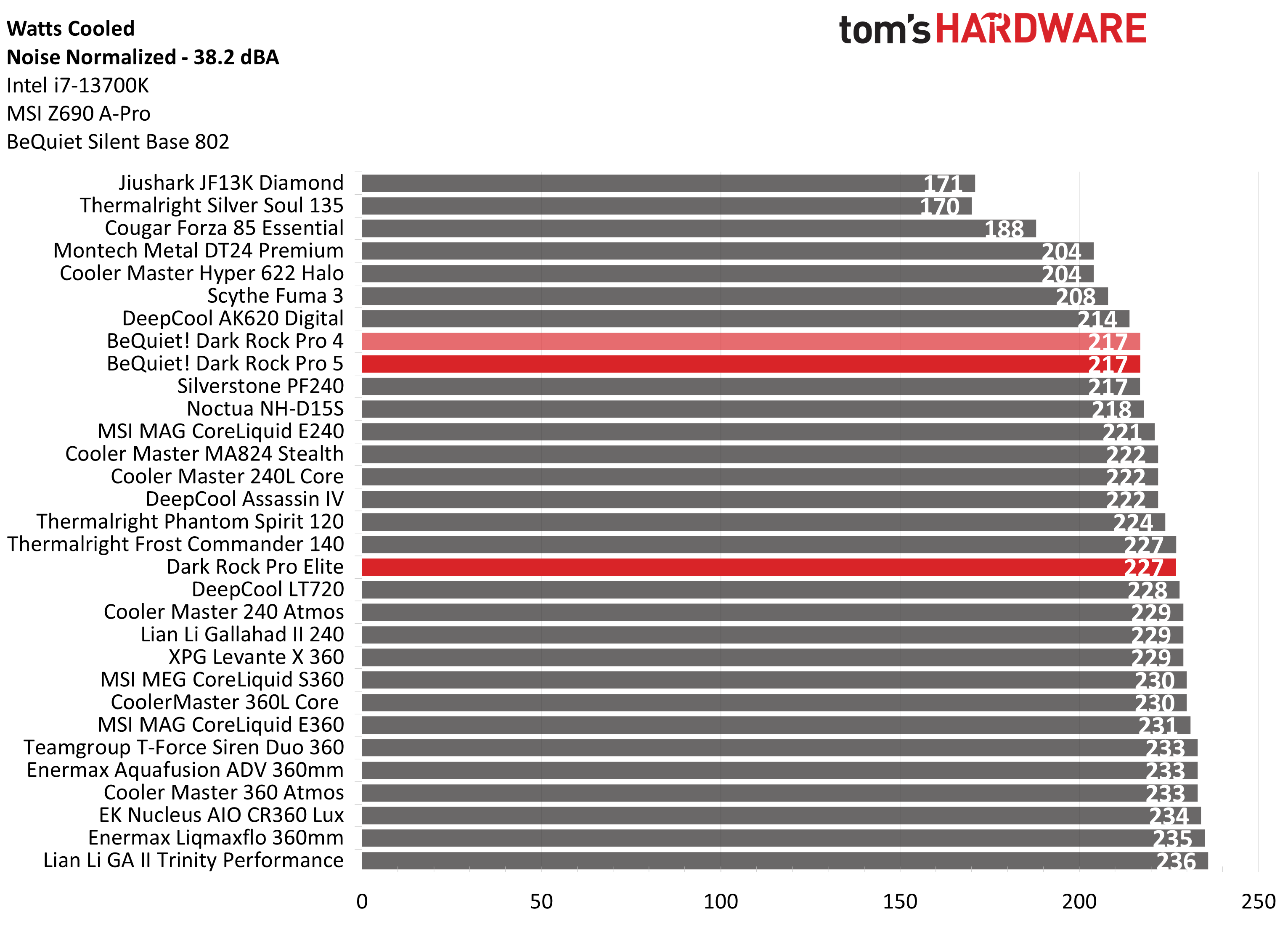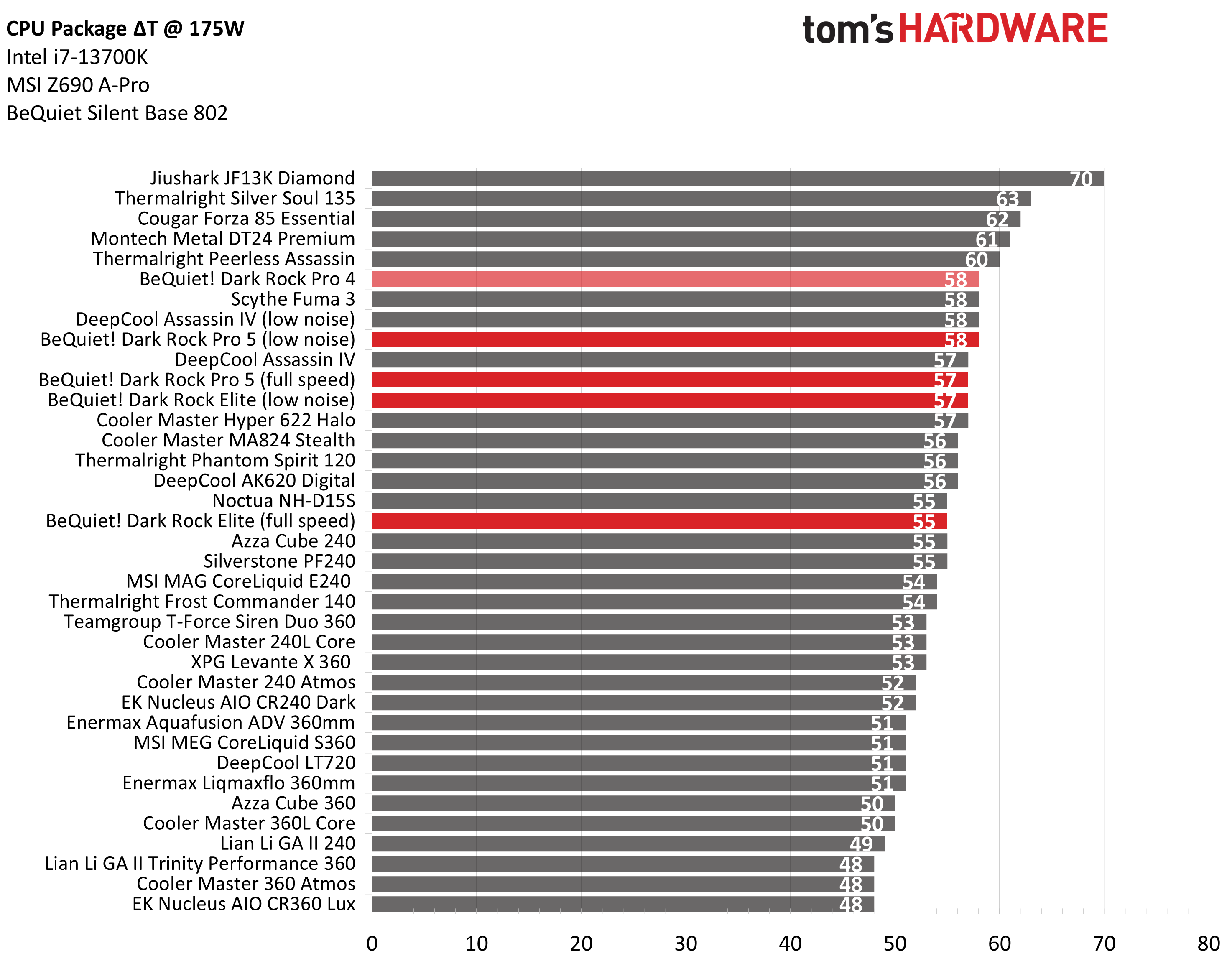Why you can trust Tom's Hardware
No Power Limits Thermal Results
Without power limits enforced on Intel’s i7-13700K, the CPU will hit its peak temperature and thermally throttle with even the strongest air coolers. When the CPU reaches its peak temperature, I measured the CPU package power to determine the maximum wattage cooled to best compare their performance.
The Dark Rock Pro 5 shows a minor improvement over its predecessor, cooling 220-225W vs the 217 of the Dark Rock Pro 4.
In its low noise mode, the Dark Rock Pro 5 runs quieter than the Dark Rock Pro 4 with a measurement of only 38.2 dBA, which is the quietest result of any air cooler tested with this system. In its full-speed mode it runs a bit louder at 41.4 dBA, but that’s still quieter than most other high-end air coolers on the market.
The Dark Rock Pro Elite shows more impressive thermal improvements, cooling 231-235W compared to the 217 of its predecessor. It does run a bit louder than the Dark Rock Pro 5 to achieve this performance, with noise levels recorded of 38.9 (low noise) and 43.4 dBA (full speed mode).
Thermal Results With Noise Normalized to 38.2 dBA
Finding the right balance between fan noise levels and cooling performance is important. While running fans at full speed can improve cooling capacity to some extent, the benefits are limited and many users prefer a quiet system. With this noise-normalized test, I’ve set noise levels to 38.2 dba. This level of noise is a low volume level, but slightly audible to most people.
The noise-normalized results for the Dark Rock Elite were simply phenomenal, tied with Thermalright’s Frost Commander 140 for the best result we’ve seen from any air cooler. For those looking for the strongest silent performance, the Dark Rock Elite is a winner.
These results don’t really show any improvement of the Dark Rock Pro 5 vs the Dark Rock Pro 4, which may disappoint those looking to run their coolers at a manually tuned low volume level. However, as you’ll see in our results below, it generally runs quieter and cooler in typical operation.
175W Cinebench Results
Most coolers on the market can keep Intel’s i7-13700K under its peak (TK Max) temperature if the power consumption is limited. So for this test, we’ll look at the CPU’s actual temperature.
Get Tom's Hardware's best news and in-depth reviews, straight to your inbox.
With results of 58 in full-speed mode and 57 degrees Celsius over ambient in low noise mode, there’s little benefit to running the Dark Rock Pro V in its full-speed mode. The same can be said for the Dark Rock Pro Elite. It runs at a typical (for coolers of its class) 42.4 dBA in its full-speed mode with a thermal result of 55 degrees C over ambient, but runs at a quiet 37.3 dBA and only 2C warmer in its low-noise mode.
The acoustic measurements in the low-noise mode for both coolers here is absolutely impressive. The sound levels of 37.3 dBA are quieter than any of the coolers we’ve tested – running 1.6 dBA quieter than the Dark Rock Pro 4 did!
125W Cinebench Results
For the last test, we’re looking at lower power results. The lowest power limit I test with Raptor Lake CPUs is 125W, high enough of a limit to allow the CPU to maintain its base clock speeds even in the most intensive tests. Most coolers should be capable of keeping the CPU below TJ Max (the max temperature before throttling) – even low-end coolers like the Intel stock cooler.
Noise levels, rather than CPU temperature, are the most important factor here. That said, the new Be Quiet coolers offer improvements of 1-2 degrees C over their predecessor.
Both coolers ran very quietly in this limited 125W scenario. I measured 37.3 dBA, which is equal to my system’s minimum noise levels – which means the cooler’s noise level is less than the system's.
To investigate this further, I put the Dark Rock Pro V and Elite and ran them at a similar thermal level in my Ryzen 7700X SFF build. Both showed results equal to the lowest measurement my noise meter can reliably measure, 36.4 dBA. What this means is that both coolers will run perfectly silent in low-power workloads, and in most common situations.
Limited AM5 Testing Results
After I completed testing on my Intel testbed, a few users asked me to test the Dark Rock Pro V and Elite on my AMD Ryzen 7 7700X SFF system after reports of poor performance on AMD AM5 systems. I wanted to investigate this but my results are limited, because I’ve only tested a few coolers on this system thus far. I haven’t included charts with my previous Ryzen 7700X testing information because they’re not 100% comparable due to using a smaller computer case and a different motherboard.
That said, you shouldn’t have any problems with performance on AMD systems using Be Quiet’s Dark Rock Pro V and Elite. I would advise that anyone experiencing less-than-expected performance on an AMD-based system should remount the cooler.
What I can say is this – compared to the data I have for my last Ryzen 7700X system in a mid-tower case, Be Quiet’s new coolers did very well. The results I have in the SFF system show a few watts of improvement in total cooling power for the Dark Rock Pro V compared to the Dark Rock Pro IV. The Dark Rock Pro Elite performed on par with the results I have for Noctua’s NH-D15S and DeepCool’s Assassin IV.
Conclusion
If you’re looking for the best-performing quiet air coolers, Be Quiet’s Dark Rock Pro V and Elite will serve you well. Their low noise modes offer the quietest acoustics we’ve seen thus far, while maintaining strong thermal performance. My only complaint about these coolers are their prices. At $89 and $99 USD, they are not cheap in any sense of the word – but the best performing products rarely offer the best value. Trying to decide between the two? I’d advise spending the extra $10 on the Elite model for stronger cooling. Even in the quiet mode it performs better than the Pro. If you just want the quietest running cooler, then you might consider the Dark Rock Pro V instead.

Albert Thomas is a contributor for Tom’s Hardware, primarily covering CPU cooling reviews.
-
helper800 At this point I think I am going to have to buy Albert the Arctic cooler components I want him to test. The Arctic freezer II 360mm and 420mm AIOs are not on any of the charts unfortunately.Reply -
Albert.Thomas Reply
I have thought about re-testing the LF2 series, but unlike other companies Arctic knows how to count to three ;)helper800 said:At this point I think I am going to have to buy Albert the Arctic cooler components I want him to test. The Arctic freezer II 360mm and 420mm AIOs are not on any of the charts unfortunately.
Maybe I'll have to pull out the LF2 360 at that time :P -
Mike500 Good review about nice coolers. However, one sentence in the Conclusion doesn't quite make sense:Reply
"Trying to decide between the two? I’d advise spending the extra $10 on the Elite model for stronger cooling. Even in the quiet mode it performs better than the Elite."
The Elite performs better than the Elite...? 😉 -
sam buddy @Albert.ThomasReply
The charts are a bit messed up methinks. The CPU package ΔΤ @ 175W chart appears twice under 175W Cinebench Results, while the Noise Levels @ Default Fan Curve chart for the 175W Power Limit also appears under the No Power Limits Thermal Results, probably in place of some other chart.
Thanks for the review and plus one for Arctic cooler reviews. -
Albert.Thomas Reply
It looks like an error occured when they updated the article yesterday, I'll let the editors know ASAP.sam buddy said:@Albert.Thomas
The charts are a bit messed up methinks. The CPU package ΔΤ @ 175W chart appears twice under 175W Cinebench Results, while the Noise Levels @ Default Fan Curve chart for the 175W Power Limit also appears under the No Power Limits Thermal Results, probably in place of some other chart.
Thanks for the review and plus one for Arctic cooler reviews.
Thank you for the report!







